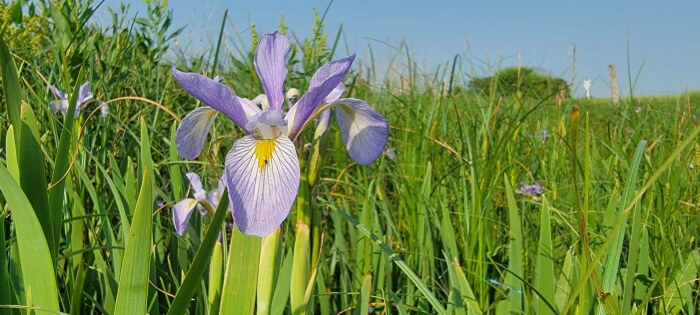Katie Byerly of Cerro Gordo County is also known as Iowa Prairie Girl on YouTube.
I remember the first time I saw a wild iris in a prairie wetland. I had no idea wild irises existed and wondered who took the time to plant an iris a mile from a road. Since then I have found Blue Flag or Blueflag Iris (Iris Virginica)—also known as Wild Blueflag Iris, Southern Blueflag, or Virginia Iris—in many marshes, wet ditches and even flooded woodlands.
Still, finding a wild iris is always still a pleasant surprise.

Blue flag can tolerate water up to 1-2 feet deep. Ancient armies would use this as an indicator of whether water was shallow enough to walk though. European rulers often used the iris as a symbol on their shields and flags. The iris stands for victory, courage and power. The Blueflag name either orginiated from these flags or from the middle English word “flakken” which means to flutter. Both ideas convey how the inflorescence moves in the wind.

The flower is not a true blue, but rather a blue-violet. The shades of blue-violet can vary. In Iowa, it is more than likely that we would find the Virginia Blueflag, which is the southern variant. Sylvan Runkel and Dean Roosa describe the flower in this manner:
The flower appears to have nine petals; in reality, it has three petals, three sepals, and three petal-like branches of the styles. These branches arch over the pollen-producing stamens to prevent self-pollination. The sepals have a yellow midrive that expands to a bright yellow, pubescent (covered with short hair) patch at the base.
Here is an top view image of the flower showing the three sets of three petals, sepals, and styles.


This image shows off the sepal with its yellow patch. I love the dark purple veining giving directions, like a landing pad for the bumblebees that cross-pollinate the flowers.

I spent some time watching large bumblebees dining at a colony of iris. They don’t spend a lot of time at one flower. They land on the sepal and crawl right in under the turned up style for the nectar, then back out butt first. They move quickly, so catching an image of them at work takes patience. Here you can see the butt of a bumblebee who is busy eating and pollinating.

A single plant can have multiple flowers. This plant caught my eye when two stems twisted together and the two flowers appeared as one with what looked like eigheteen “petals.”

The bluish-green leaves are basal (beginning at the base of the plant). The sword-like leaves can get up to 3 feet tall and usually stand erect, sometimes curving at the tips. Native Americans used the outer edges of the leaves to weave strong rope.

When I am in the field, I try to remember to take a picture of the backside of the flower. In some cases the bracts are necessary to assist with identification. Although this is not the case with the Blueflag Iris, it is neat to see the yellow patch and purple vein on the bottom of the flower.

Further up the stem, smaller alternate leaves develop, and from the axils of these leaves, the flowers shoot up on long stems.

The root of the iris is a rhizome and can develop into dense clumps of plants. Native Americans would transplant Blueflag to ponds when they moved villages. I imagine the rhizome made it easy to move the iris, just like receiving iris from a relative’s or friend’s garden.

The flower develops a seed pod, which is a three-celled capsule. Each capsule contains two rows of seeds. When the pods dry and pop open, the seeds float in the water to develop other iris colonies.

A northern version of Blueflag is found in states like Minnesota and Michigan. It is a deeper blue-violet with less yellowing. Here are two images of Northern Blueflag, which I saw during a recent trip to Michigan.


Blueflag Iris bloom from late spring into early summer. A colony of plants might have blooms for a month, but each flower only lasts a few days. You might be fortunate to find Blueflag in a wet ditch or along a pond’s edge, or it might take a bog walk or a boat ride in a marsh to find this beauty. I hope when you find her, she is a pleasant find.

For more on Blueflag Iris, watch my Iowa Prairie Girl YouTube video.


1 Comment
These photos are all really nice...
…but that bumblebee butt-shot is my favorite, and thank you!
PrairieFan Mon 31 Jul 1:42 AM